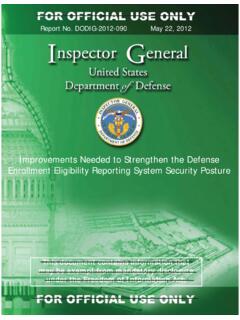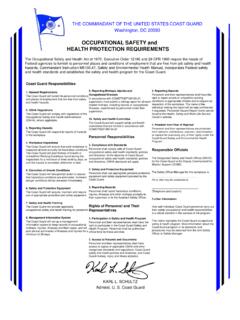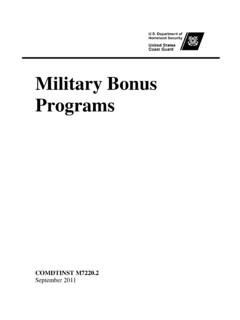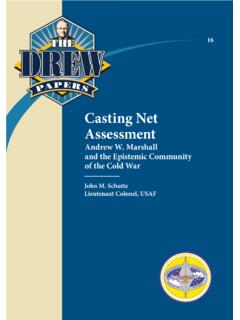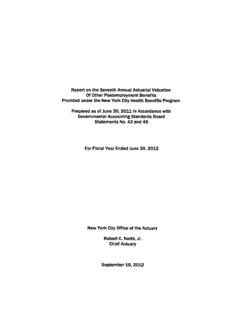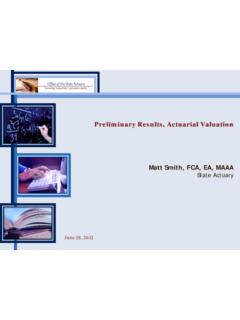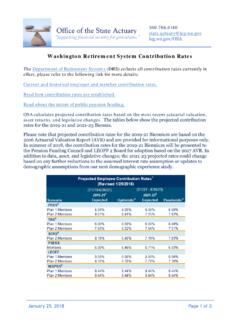Transcription of DoD Office of the Actuary, December 2014
1 DoD Office of the actuary , December 2014 Page 2 The DoD Office of the actuary (OACT) annually performs two MERHCF valuations. The primary one is for funding purposes, is governed by Chapter 56 of Title 10 , and must use methods and assumptions approved by the DoD Medicare-Eligible Retiree Health Care Board of Actuaries (Board). As noted above, details of the funding valuation are described in OACT s annual Valuation of the Medicare-Eligible Retiree Health Care Fund. The other valuation is for financial statement purposes and is governed by FASAB standards. For the September 30, 2014, financial statement valuation, OACT determined an SFFAS 33 equivalent discount rate of (compared to in the previous year) by using quarterly zero coupon Treasury spot rates.
2 In previous years, these spot rates were obtained from a series published by the Office of Thrift Supervision. This year, OACT used the Department of Treasury Office of Economic Policy s 10-year Average Yield Curve for Treasury Nominal Coupon Issues (TNC yield curve), which represents average rates from April 1, 2004, through March 31, 2014 . In the summer of 2014, the Board approved a discount rate of for the September 30, 2013, funding valuation, which differs from the SFFAS equivalent rate by 145 basis points. SFFAS 33 requires that the discount rate, underlying inflation rates, and other economic assumptions be consistent with one another. A change in the discount rate may cause other assumptions to change as well.
3 For the September 30, 2014, financial statement valuation, use of the SFFAS 33 single equivalent discount rate required OACT to change the long-term inflation and medical trend rate assumptions to be consistent with the underlying Treasury spot rates used in the valuation. Looking at inflation over the same period used to develop the yield curve led to a long term inflation assumption of (same as in the previous year), which is 60 basis points lower than the long term inflation assumption for the funding valuation. Therefore, the long-term (or ultimate) medical trend assumption was set to (same as in the previous year), also 60 basis points lower than the comparable funding valuation assumption.
4 PROCESS OVERVIEW The year-end financial statements, called the CFO financial statements, report PRB liabilities in total as well as in components. The following list describes the various components of the PRB liabilities needed for financial reporting. 1. MERHCF The Medicare-Eligible Retiree Health Care Fund covers the liability for the cost of future medical treatment provided to Medicare eligible military retirees and dependents. a. Benefits: purchased care (PC) care and prescriptions received from civilian providers at civilian locations, and direct care (DC) care and prescriptions received from providers hired by DoD (located at Military Treatment hospitals and clinics or MTFs) b.
5 Population: All Uniformed (DoD + Non-DoD1 (CG, NOAA, PHS)) (Active Duty and Reserves); beneficiaries must be eligible for Medicare 2. CRM and DHA Contract Resource Management (part of Defense Health Agency) covers Purchased Care (PC) benefits. The CRM and DHA financial statements include a liability for future retiree medical benefits received through PC and provided to non-Medicare eligible military retirees and dependents. The DHA statement also includes a small death benefit liability for a small closed group of retirees who previously were employed at the Uniformed Services University of the Health Sciences (USUHS).
6 A. Benefits: PC b. Population: DoD (Active Duty and Reserves); beneficiaries are not eligible for Medicare 1 The non-DoD uniformed services (the US Coast Guard (CG), National Oceanic and Atmospheric Administration (NOAA), and Public Health Service (PHS)) together add about to active duty endstrength and 1% to reserve endstrength. DoD Office of the actuary , December 2014 Page 3 3. SMA Service Medical Activity covers Direct Care (DC) benefits. The SMA financial statement includes a liability for future retiree medical benefits received through Direct Care and provided to non-Medicare eligible military retirees and dependents.
7 A. Benefits: DC b. Population: DoD (Active Duty and Reserves); beneficiaries are not eligible for Medicare 4. MRHB Military Retirement Health Benefit covers PC and DC retiree medical benefits provided to non-Medicare eligible retirees and dependents. The MRHB liability is included in the DoD Agency-wide Financial Statement and combines the liabilities recorded in the CRM and SMA statement liabilities. The remaining liability for postretirement medical benefits is found in the individual financial statements of the non-DoD uniformed services (CG, NOAA, and PHS). Therefore, CG, NOAA, and PHS are responsible for computing and recording their liabilities for non-Medicare postretirement medical benefits.
8 SUMMARY OF STATEMENT CONTENTS OACT produces various items associated with the actuarial valuation of postretirement benefits, and DoD s funding and reporting requirements drive OACT s business cycle. During FY 2014 (Oct. 2013 Sept. 2014), OACT first produced an actuarial valuation for the MERHCF as of FYE 2013. Census data for this valuation were as of FYE 2013. Claim vectors were produced from detailed medical claims data from FY 2011 FY 2013 and then trued up to FY 2013 incurred cost levels using FY 2013 incurred claims estimates derived from March 2014 claims triangles. This valuation was used to determine the annual unfunded liability amortization payment on October 1, 2014 (FY 2015 payment).
9 The Normal Cost payment made on October 1, 2014 (FY 2015) was based on per capita NCs originally produced from the MERHCF valuation as of FYE 2012. The FYE 2014 financial statements (FS) include several types of actuarial liabilities and reconciliations of postretirement military medical benefits. This work was due in September 2014 in order to be recorded in the FYE 2014 financial statements in October. Therefore, OACT used valuation results as of FYE 2013 to produce the roll-forward gain/loss exhibits for FYE 2014. The starting point of the reconciliations was the prior year's CFO valuation results ( , rolled forward from the September 30, 2012, valuation).
10 The list of deliverables included: Reconciliation of the MERHCF liability from 9/30/2013 to 9/30/2014, and DDRS2 Note 17 Reconciliation of the CRM statement liability from 9/30/2013 to 9/30/2014, and DDRS Note 17 Reconciliation of the SMA statement liability from 9/30/2013 to 9/30/2014, and DDRS Note 17, and breakout of SMA liability reconciliation by service Reconciliation of the MRHB (SMA + CRM, or pre-Medicare retiree medical) statement liability from 9/30/2013 to 9/30/2014, and DDRS Note 17 Each reconciliation step3 has the same general format for the gain/loss exhibit, and complies with the disclosure requirements of SFFAS 33: 2 Defense Departmental Reporting System DoD s internal system for its financial statements.
